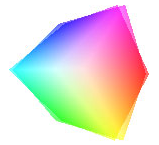
Vincent Cogne found some time (between evaluations and the whatnots of end-of-semester madness) to put up the source code to the solution he found for creating stereoscopic Processing sketches [link]. We tried a few different solutions before this one (well, to be honest, I just made teacherly suggestions with a lot of OpenGL theory and Vincent did all the work). This was all while Ben Chang was here teaching us his solution using Ygdrasil. I think Ben has done great work on making a viable solution, but I just cringed when I saw all the hackery-clickery that had to be done just to set the environment up. I figured there had to be a better way.
The advantage of Ygdrasil over Processing/OpenGL is that it’s higher level, so you can just say « put this model here, and that model there » and the thing takes care of it for you (sort of like Shockwave3d in that sense, but on a more serious foundation). But on the other end, from an artistic perspective, I actually prefer to work closer to the bone — screwing around with the OpenGL directly because you get more visually interesting results (= easier to make pretty mistakes). But that’s just me. Anyway, with Vincent’s solution we were able to play around with the basics of stereoscopic imagery very quickly, and in the little hour I found to fiddle around with it, I saw the power of working this way rather than the higher-level stuff. You can iterate the designs so much faster this way (thank you Processing). I wish I had more time to play with it, but ultimately that’s the great thing about running an atelier : you can follow several different directions simultaneously.
As a side note, we also noticed very quickly that the stereoscopic images really pop out of the stucture better if you work off of a black backround. In other words, if you lose the « image » reference, and even lose the frame, and work off of the structure as if it were an architectural element within the room and not just a big TV screen. This is the mistake most « Virtual Reality » environments make (god I hate that term). They make a huge effort to get stereoscopic images, and then project it onto a conventional surface.
Oh, if you don’t know how to make a stereoscopic image, it’s actually very similar to how to make a Hypertable. But in this case, you need two projectors, with polarized filters, and a rear-projection screen that respects the polarization. (Huh? That’s not much of an explanation) Oh, just ask Vincent, he’ll explain it to you. He’s quite brilliant at everything 3d-programmable, so go bug him. I just got off the plane for @&#§$*@#¡ and I need some sleep.
And while we’re on the subject of 3d engines (see that? it’s called the bait-and-switch), John Klima just finished a two week workshop at the school showing our students how to use the Torque Game Engine. I didn’t have the time to hang out with them as much as I would have liked, but I got enough of a glimse to know that it’s an even better soluton than XNA which was really bothering me because of the licence, the Microsoft-centric aspect, etc. Whereas Torque is Mac/PC/Linux/Xbox. Pretty impressive. So like XNA, you can make Xbox360 games with it (and even distribute over Xbox Live Arcade, although that’s far more complicated because you have to go through the Bill, even if Bill does give you a good cut).
Jack Stenner took some time out at ISEA2006 to walk me through Torque as well and I had left with a good impression. We were exhibiting next to one another and often up late plugging things in, so I got to see how the system worked for him. As with everything, there are some wonky aspects, but so what, it’s open-source and cheap. And I think that’s really cool that there is a viable open-source platform for gaming. In fact, I would even go so far as to suggest that we will not have a true massive gaming culture (on the same scale and deep influence as cinema, for example) until the platform becomes truly open and open-source. No one has a patent on 24-images-per-second, so too should it be for game platforms.
Enough techno-art-geek soap boxing for tonight. Zzzzz….
